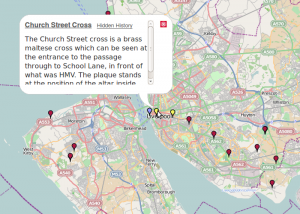Historic Liverpool is now open for your contributions
Liverpool Landscapes was a blog charting new discoveries, news and developments affecting Liverpool's historic environment. It was regularly updated between 2007 and 2016.
Liverpool Landscape has now been retired, and most of the less time-dependent articles moved to Historic Liverpool.

Today I’m going to introduce a new feature to this blog’s sister site, Historic Liverpool: I want you to help me write articles for it, and build a map of Liverpool history.
I’ve been (very) slowly adding new posts to Historic Liverpool for many years now, and it’s become more than obvious that if the site is ever going to reach its goal of being the best resource for Liverpool history, then I’m going to need help.
From today you will be able to register your own account on Historic Liverpool, sign in and create articles on any historical feature on Merseyside that you think deserves attention. We’re going to start with a couple of categories, but I’ll be adding more as the months go by.
All this work of yours will end up on a map, on the Liverpool History Map page. There’s already a handful of points on that map. Click on one, and follow the link to read more. If you get the message “Sorry, there’s not yet an article on…” then perhaps you’d like to volunteer to do it? First come first served! I’ve grabbed a couple of the prime sites myself – I want to see what you can offer on your own patch before letting you free on the Three Graces.
The biggest category on the map is going to be historic buildings. Liverpool has more than its fair share, and although many of them are rightly world famous, there are hundreds of others which are just as important, but for which information is lacking. Whether you know Liverpool well from living there for decades, or your ancestors or relations came from here, I want you to research those buildings you know best – your local church, the large house up the wooded drive which sits oddly in a modern housing estate, the remains of an ancient field boundary which dozens of people walk past every day.
I want your help bringing these historic gems to light.
How to contribute to Historic Liverpool
OK, so that’s the general gist of things. In a nutshell:
- Head over to http://historic-liverpool.co.uk;
- Scroll to the foot of the page, to find the ‘Info’ section, where you will see a link called ‘Register’. Click on this link.
- Choose a user name (such as ‘Martin Greaney’ or ‘mgreaney’ – spaces are allowed) and type in your email address. Then fill in the box underneath with the distorted words you see above it – this is just to check you’re not a spamming robot!
- You will then be emailed a password to the email address you’ve just entered. Enter your username and password into the boxes at http://historic-liverpool.co.uk/wp-login.php, and you will be taken the Historic Liverpool Dashboard.
You may now write your article! See the instructions in the Guide to Contributors. There are also a couple of guidelines there, so have a glance through them to keep this whole endeavour fun and fair.
If you’ve had any trouble with this process so far, you can also email me via the Contact page and I can set up an account for you. Just let me know which email address and username you would like.
Why should I contribute to Historic Liverpool?
There are lots of reasons why contributing to Historic Liverpool is worthwhile:
- All articles will have your name at the top of them – show the world what you know about Liverpool’s history!
- Connect with like-minded individuals in the comments section on your articles and theirs, then visit the Historic Liverpool Facebook page and discuss your next article.
- Contribute to the pool of knowledge (if you’ll pardon the pun) – the more of us who add an article, the more everyone benefits.
- There is no other reader-built historical resource like it. Scousers have all sorts of special knowledge about their town – about the historic buildings, the people, the culture, the highs and the lows. Liverpudlian pride is unparalleled in Britain. Historic Liverpool will be a place for people of all sorts (not just historians) to tell the world about their city.
- This is just the start. As time goes on, I’ll be adding more features to let you do more. Perhaps there’ll be a points system, or leader boards for those with the most articles, and the most-read! I’m open to ideas on this to – nothing’s out of bounds for now! So start contributing today, and soon you might be crowned King of Childwall History!
I’ll be adding my own articles too, but now I won’t be so daunted about having to write the whole lot myself!
What if my article doesn’t fit a category?
I’m particularly keen on seeing articles about historic buildings dotted around the city, or other hidden features that only locals might know about. However, I’m also happy for you to write about the building you work in, a shop you visit, or anything you know something about.
In addition to buildings and the ‘Hidden History’ category, I want to hear your suggestions for other themes. Do you want to write about statues? Fountains? Parks? Let me know, and I’ll add a category for you.
However, I may suggest something else if your idea falls outside these bounds. The new map wants to concentrate on sites: buildings, archaeological findspots and the like, but if you want to write about something bigger, then let me know – I may suggest it goes here on Liverpool Landscapes, which is the place for longer articles on interesting topics, especially ones which don’t fit on a map as such.



